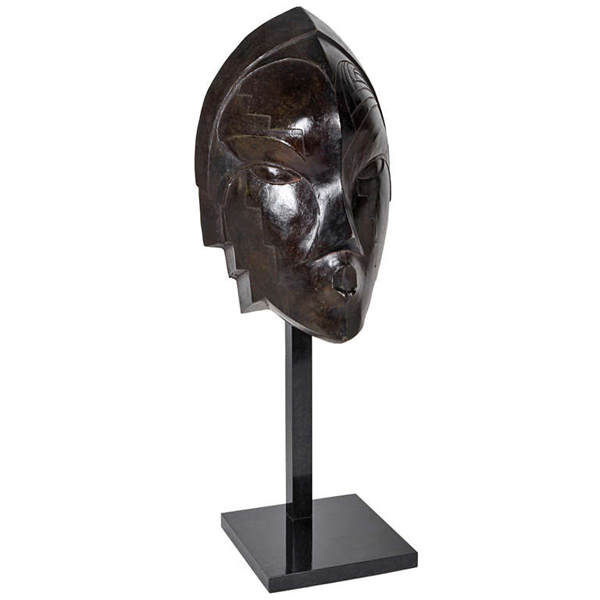Cubist
-
Andree Flamant-Ducany-Gide / Valsuani Foundry French Cubist bronze “African” mask sculpture 20th Century
ANDREE FLAMANT-DUCANY-GIDE (1882-1970) France
VALSUANI FONDEUR (1899-1981) Paris, FranceCubist mask sculpture 20th Century
Cast bronze with rich brown-black patina (possibly cast at a later date by the Valsuani Foundry)
Marks: G. Flamant, 2/8 C. Valsuani Cire Perdue (signed on chin)
H: 11” x W: 7” x D: 5 ½”;
On stand: H: 18 ½”Price: $35,000
ANDREE FLAMANT-DUCANY-GIDE
Flamant-Gide was born in Nimes, France on January 2nd, 1892 and died on March 28th 1970. She was both a painter and sculptor and exhibited regularly at the Salon des Artists Francais beginning in 1923. She sculpted in an angular Cubist style influenced by African Art and was a fellow artist of Joseph Csaky, Gustave Miklos, Jacques Lipchitz and Henri Laurens who were considered the leading Art Deco sculptors in Paris during the 1920’s.CUBISM
Cubism drew its influence from: Cezanne’s structural analysis in his oil landscapes, e.g. ‘La Montagne Sainte Victorie’ c.1887; Gauguin’s figurative landscapes, e.g. ‘Haymaking’ 1889; and African tribal Art such as Gabon masks. European artists were greatly influenced by African and Oceanic Art during the late 1890s and early 1900s. African sculpture, with its bold shapes and lines, had a great impact on the development of Cubism. Maurice de Vlaminck became a keen admirer and collector of African masks after seeing them in a Paris anthropological museum. He purchased similar masks and his excitement for these works displaying bold primitive expressions and simplistic design filtered through to Matisse, Derain, Gris and Picasso, who all became collectors as well. By the 1920s African art exhibitions were common in Paris and other cities throughout Europe.
Cubist sculpture brought the simplified shapes of Cubist painting together with the three-dimensional modeling medium of sculpture. The first Cubist sculpture, which could be properly deemed as such was made by Picasso in 1909 and was titled ‘Head of a Woman’. However Picasso did experiment with sculptural forms as early as 1907 when he found himself fascinated and deeply influenced by African masks. Cubist sculpture was mostly reminiscent of Analytical Cubism in its stripping away of illusionist details to reveal the fundamental form contained in each individual subject, be it human or still-life.VALSUANI FOUNDRY
The Valsuani foundry was started by the brothers Claude and Attilio Valsuani who learned the foundry trade while employed at the Hebrard foundry. While working for Hebrard, Claude Valsuani showed great promise as a finisher and eventually worked his way up to become the Technical Director of the Hebrard foundry. In 1899 Claude Valsuani started his own foundry in Chatillon, casting mostly small works for various artists primarily using the lost wax technique of casting (cire perdue). In 1905 he moved his foundry to 74 Rue des Plantes in Paris. Among the famous sculptors who had the Valsuani foundry cast their works were: Renoir, Picasso, Despiau, Paul Troubetzkoy, Matisse, and Gaugin. Claude Valsuani died in 1923 in his native Italy but his son, Marcele then took over the foundry and continued the tradition of producing extremely fine bronzes until the 1970’s. -
Margaret Postgate / Cowan Pottery Studio American Art Deco Cubist Elephant bookends c. 1929
MARGARET POSTGATE (1879-1953) USA
WAYLANDE GREGORY (1905-1971) USA
ARTHUR BAGGS (1886-1947) (glaze development) USA
COWAN POTTERY STUDIO USA
Cubist Elephant bookends 1929
Ceramic bookends with a black gunmetal glaze
Signed: Cowan studio mark (under glaze) Cowan bookend numbers 840 and 841
For more information and illustration see: Cowan Pottery and the Cleveland School, by Mark Bassett and Victoria Naumann (Atglen, PA: Schiffer, 1997).
H: 4 1/2″ x W: 5 1/2” x D: 3 3/4”
Margaret J. Postgate was born in Chicago, IL on September 29, 1879 and died at a hospital in the Bronx, NY in 1953. Her family moved to Manhattan around 1910 and then Brooklyn around 1925 and she remained a Brooklyn resident right up until her death. Her parents were both born in England: John W. Postgate and Margaret Postgate nee Derry. She had siblings, a brother George and one or two sisters, Mary and/or Mae. Margaret studied at the Art Institute of Chicago and Cooper Union School of Art in New York. In 1925, 1925, and 1926 she participated in soap sculpture carving competitions, some sponsored by Procter & Gamble Corporation in Cincinnati, Ohio. Pamphlets exist as well as exhibition brochures and others on “how-to” carving penned by Postgate. Margaret Postgate designed for Cowan from 1929-1930 where she adapted a few of the designs she had rendered in soap for ceramic sculptures for the Cowan Pottery. She also executed a few pieces of sculpture that were cast in bronze for the bronze division of the Gorham Manufacturing Company.


